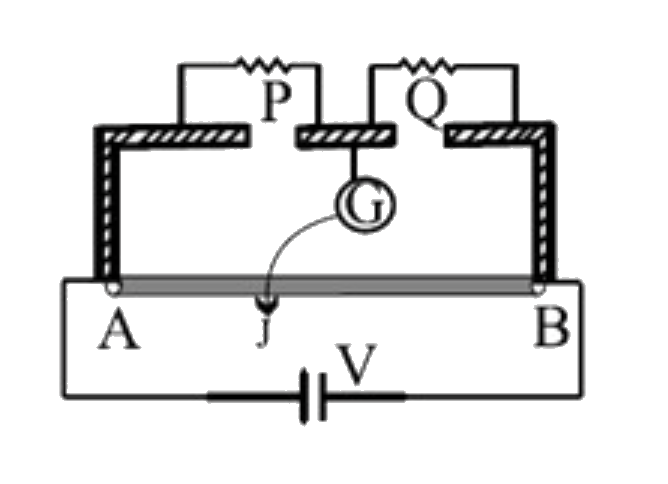A metallic conductor at 10∘C connected in the left gap of meter bridge gives balancing length 40 cm. When the conductor is at 60°C, the balancing point shifts by ---cm, (temperature coefficient of resistance of the material of the wire is (1/220)/∘C)
4.8
10
15
7
The correct Answer is:A
To solve the problem step by step, we will follow the outlined process to find the change in balancing length when the temperature of the metallic conductor changes from 10°C to 60°C.
Step 1: Understand the given data
- Initial temperature (T1) = 10°C = 283 K
- Final temperature (T2) = 60°C = 333 K
- Initial balancing length (L1) = 40 cm
- Temperature coefficient of resistance (α) = 1/220 °C
Step 2: Set up the equations for the meter bridge
Using the meter bridge principle, we have:
1. For the first case (at 10°C):
R1R2=L1100−L1
Let R2=q (resistance in the right gap). Thus:
R1q=4060=23
Therefore, we can express R1 as:
R1=23q
Step 3: Express the resistance at different temperatures
The resistance of the conductor at temperature T can be expressed as:
R=R0(1+αT)
Where R0 is the resistance at 0°C. Thus:
- At T1=10°C:
R1=R0(1+α⋅10)
- At T2=60°C:
R′1=R0(1+α⋅60)
Step 4: Set up the equation for the second case
For the second case (at 60°C), let the new balancing length be L:
R′1q=L100−L
Substituting R′1:
R0(1+α⋅60)q=L100−L
Step 5: Formulate the ratio of resistances
Now we can set up the ratio of the resistances from both cases:
R0(1+α⋅10)R0(1+α⋅60)=L1L
This simplifies to:
1+1220⋅101+1220⋅60=40L
Step 6: Substitute values and solve for L
Substituting the values:
1+102201+60220=40L
Calculating the left side:
1+1221+311=22/22+1/2211/11+3/11=23/2214/11=23⋅1122⋅14
Calculating this gives:
253308=40L
Cross-multiplying gives:
253L=40⋅308
Calculating 40⋅308=12320:
L=12320253≈48.7 cm
Step 7: Calculate the change in balancing length
The change in balancing length is:
ΔL=L−L1=48.7−40=8.7 cm
Final Answer
The balancing point shifts by approximately 8.7 cm.
- Initial temperature (T1) = 10°C = 283 K
- Final temperature (T2) = 60°C = 333 K
- Initial balancing length (L1) = 40 cm
- Temperature coefficient of resistance (α) = 1/220 °C
Using the meter bridge principle, we have:
1. For the first case (at 10°C):
R1R2=L1100−L1
Let R2=q (resistance in the right gap). Thus:
R1q=4060=23
Therefore, we can express R1 as:
R1=23q
The resistance of the conductor at temperature T can be expressed as:
R=R0(1+αT)
Where R0 is the resistance at 0°C. Thus:
- At T1=10°C:
R1=R0(1+α⋅10)
- At T2=60°C:
R′1=R0(1+α⋅60)
For the second case (at 60°C), let the new balancing length be L:
R′1q=L100−L
Substituting R′1:
R0(1+α⋅60)q=L100−L
Now we can set up the ratio of the resistances from both cases:
R0(1+α⋅10)R0(1+α⋅60)=L1L
This simplifies to:
1+1220⋅101+1220⋅60=40L
Substituting the values:
1+102201+60220=40L
Calculating the left side:
1+1221+311=22/22+1/2211/11+3/11=23/2214/11=23⋅1122⋅14
Calculating this gives:
253308=40L
Cross-multiplying gives:
253L=40⋅308
Calculating 40⋅308=12320:
L=12320253≈48.7 cm
The change in balancing length is:
ΔL=L−L1=48.7−40=8.7 cm
The balancing point shifts by approximately 8.7 cm.
Topper's Solved these Questions
- APPENDICES ( REVISION EXERCISE )BOOK - AAKASH SERIESCHAPTER - APPENDICES ( REVISION EXERCISE )EXERCISE - REVISION EXERCISE (MOVING CHANGES & MEGNETISM)
95 Videos
- APPENDICES ( REVISION EXERCISE )BOOK - AAKASH SERIESCHAPTER - APPENDICES ( REVISION EXERCISE )EXERCISE - REVISION EXERCISE (MAGNETISM AND MATTER )
52 Videos
- APPENDICES ( REVISION EXERCISE )BOOK - AAKASH SERIESCHAPTER - APPENDICES ( REVISION EXERCISE )EXERCISE - REVISION EXERCISE (ELECTRIC POTENTIAL & CAPACITANCE )
143 Videos
- ALTERNATING CURRENTBOOK - AAKASH SERIESCHAPTER - ALTERNATING CURRENTEXERCISE - EXERCISE - III
24 Videos
- APPENDICES (REVISION EXERCISE)BOOK - AAKASH SERIESCHAPTER - APPENDICES (REVISION EXERCISE)EXERCISE - LAW OF MOTION
128 Videos
Similar Questions
A metallic conductor at 10∘C connected in the left gap of Meter Bridge given balancing length 40cm. When the conductor is at 60∘C, the balancing point shifts by__cm, (temperature coefficient of resistance of the material of the wire is (1/220)/∘C)
View SolutionIf the resistance of a conductor is 5Ω at 50∘C and 7Ω at 100∘C then the mean temperature coefficient of resistance of the material is
View Solution
Knowledge Check
When a metal conductor connected to left gap of a meter bridge is heated, the balancing point
Ashifts towards rightBshifts towards leftCremains unchangedDremains at zeroA wire connected in the left gap of a meter bridge balance a 10Ω resistance in the right gap to a point, which divides the bridge wire in the ratio 3:2. If the length of the wire is 1m. The length of one ohm wire is
A0.057mB0.067mC0.37mD0.134m
In meter bridge when P is kept in left gap, Q is kept in right gap, the balancing length is 40cm. If Q is shunted by 10Ω, the balance point shifts by 10cm. Resistance Q is
View SolutionA metallic wire has a resistance of 3.0Ω at 0∘C and 4.8Ω at 150∘C. Find the temperature coefficient of resistance of its material.
View SolutionResistance in the two gaps of a meter bridge are 10ohm and 30ohm respectively. If the resistances are interchanged he balance point shifts by
View SolutionA 6Ω resistance is connected in the left gap of a meter bridge. In the second gap 3Ω and 6Ω are joined in parallel. The balance point of the bridge is at _______
View SolutionIn a meter bridge circuit as shown in the figure, the bridge is balanced when AJ=20 cm. On interchanging P and Q the balance length shifts by

View SolutionIn meter bridge , the balancing length from left is found to be 20 cm when standard connected of 1Ω is in right gap . The value of unknown resistance is
View Solution
